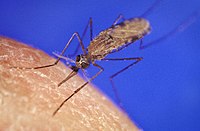
Photo from wikipedia
Simple Summary Targeting mosquitoes with insecticides is one of the most effective methods to prevent malaria transmission. Although numbers of malaria cases have declined substantially this century, this pattern is… Click to show full abstract
Simple Summary Targeting mosquitoes with insecticides is one of the most effective methods to prevent malaria transmission. Although numbers of malaria cases have declined substantially this century, this pattern is not universal and Burkina Faso has one of the highest burdens of malaria; it is also a hotspot for the evolution of insecticide resistance in malaria vectors. We have established laboratory colonies from multiple species within the An. gambiae complex, the most efficient group of malaria vectors in the world, from larval collections in southwest Burkina Faso. Using bioassays with different insecticides widely used to control public health pests, we provide a profile of insecticide resistance in each of these colonies and, using molecular tools, reveal the genetic changes underpinning this resistance. We show that, whilst many resistance mechanisms are shared between species, there are some important differences which may affect resistance to current and future insecticide classes. The complexity, and diversity of resistance mechanisms highlights the importance of screening any potential new insecticide intended for use in malaria control against a wide range of populations. These stable laboratory colonies provide a valuable resource for insecticide discovery, and for further studies on the evolution and dispersal of insecticide resistance within and between species. Abstract Pyrethroid resistance in the Anopheles vectors of malaria is driving an urgent search for new insecticides that can be used in proven vector control tools such as insecticide treated nets (ITNs). Screening for potential new insecticides requires access to stable colonies of the predominant vector species that contain the major pyrethroid resistance mechanisms circulating in wild populations. Southwest Burkina Faso is an apparent hotspot for the emergence of pyrethroid resistance in species of the Anopheles gambiae complex. We established stable colonies from larval collections across this region and characterised the resistance phenotype and underpinning genetic mechanisms. Three additional colonies were successfully established (1 An. coluzzii, 1 An. gambiae and 1 An. arabiensis) to add to the 2 An. coluzzii colonies already established from this region; all 5 strains are highly resistant to pyrethroids. Synergism assays found that piperonyl butoxide (PBO) exposure was unable to fully restore susceptibility although exposure to a commercial ITN containing PBO resulted in 100% mortality. All colonies contained resistant alleles of the voltage gated sodium channel but with differing proportions of alternative resistant haplotypes. RNAseq data confirmed the role of P450s, with CYP6P3 and CYP6Z2 elevated in all 5 strains, and identified many other resistance mechanisms, some found across strains, others unique to a particular species. These strains represent an important resource for insecticide discovery and provide further insights into the complex genetic changes driving pyrethroid resistance.
Journal Title: Insects
Year Published: 2022
Link to full text (if available)
Share on Social Media: Sign Up to like & get
recommendations!